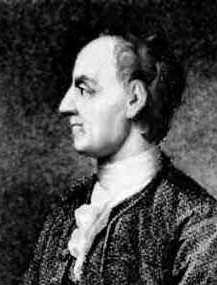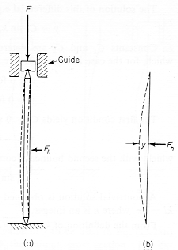|
Materials
loaded in compression may exhibit two types of elastic response. At low
stress levels the sample behaves elastically, obeying Hooke's law:
s
= E e.
Samples with a high length to area ratio show another deformation mode
at high stresses. The material buckles above a stress threshold and the
sample will show a lateral displacement. This is the Euler buckling. If
strain rate is controlled, reversing the strain after buckling permits
the sample to regain its initial configuration, indicating that the buckling
response is elastic.
Leonhard Euler, Switzerland, (1707 to 1783) |
|
|
|
|
|
|
|
|
|
|
|
|
The
diagram shows the behavior of a slender sample with ends constrained to
lie on the compression axis but free to rotate. The threshold force at
which buckling occurs for this case is given for a rod of circular crosssection
by:
F
= ( n2 p2
E I / L2 ) = (n2
p2
E A2 /
4 L2 ),
where n is a mode number, I the geometric moment of inertia, A area, L
length, and E Young's modulus. The lowest energy mode occurs first and
for this n = 1. |
|

